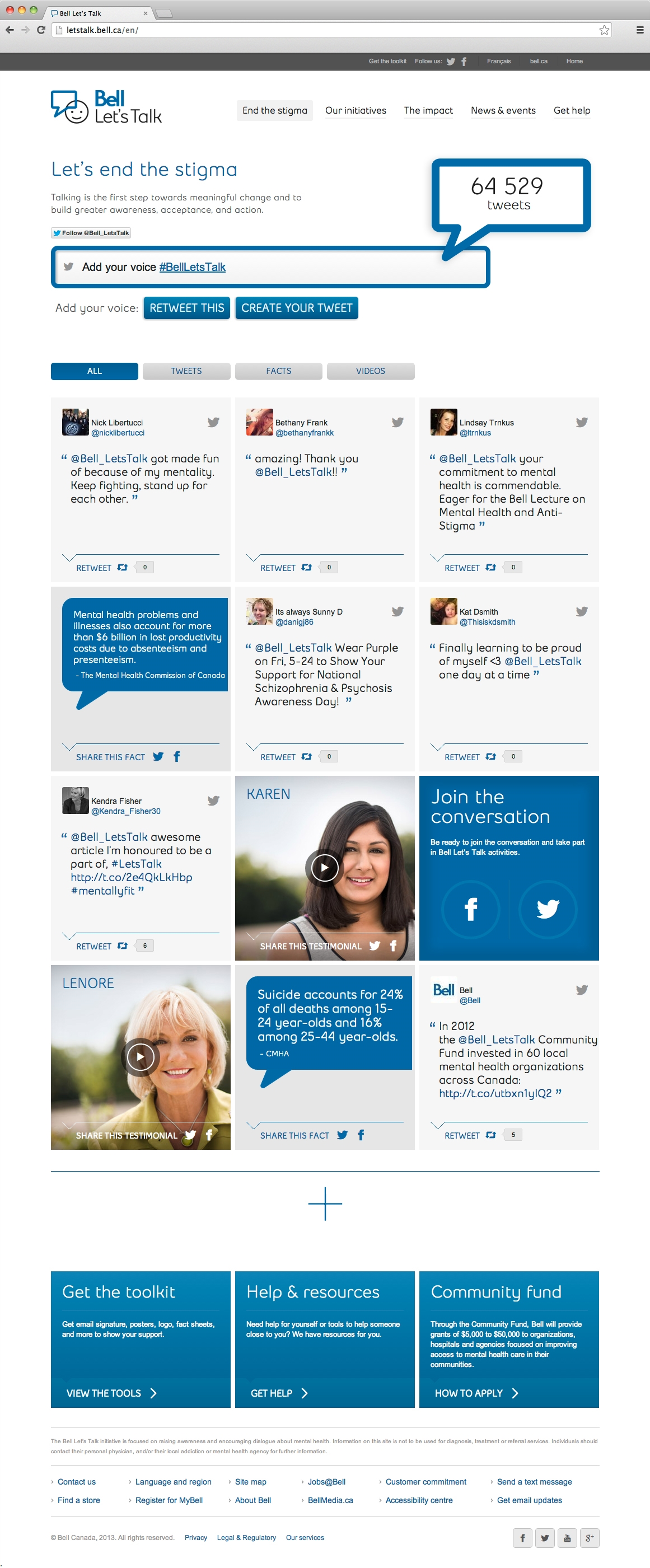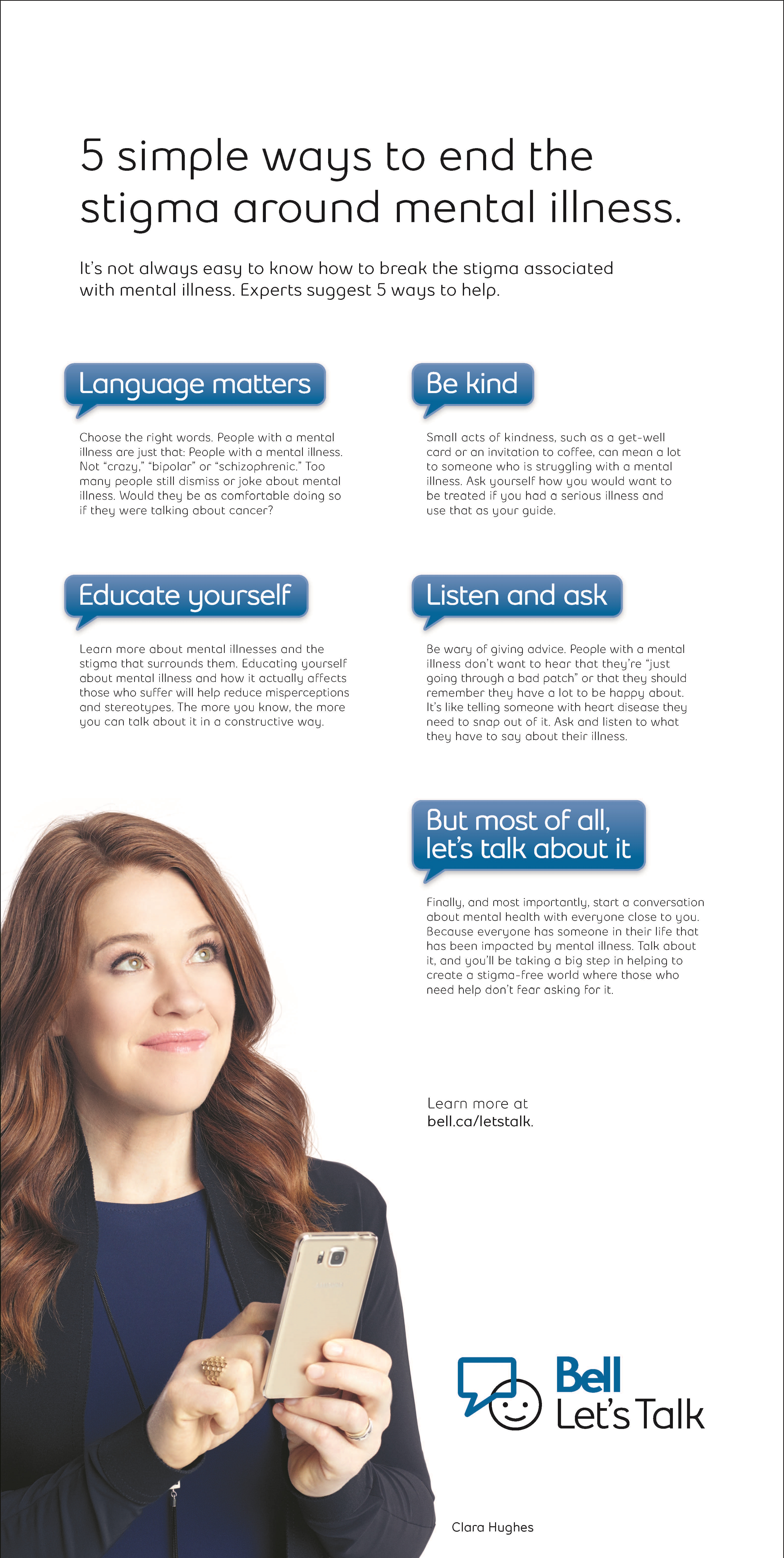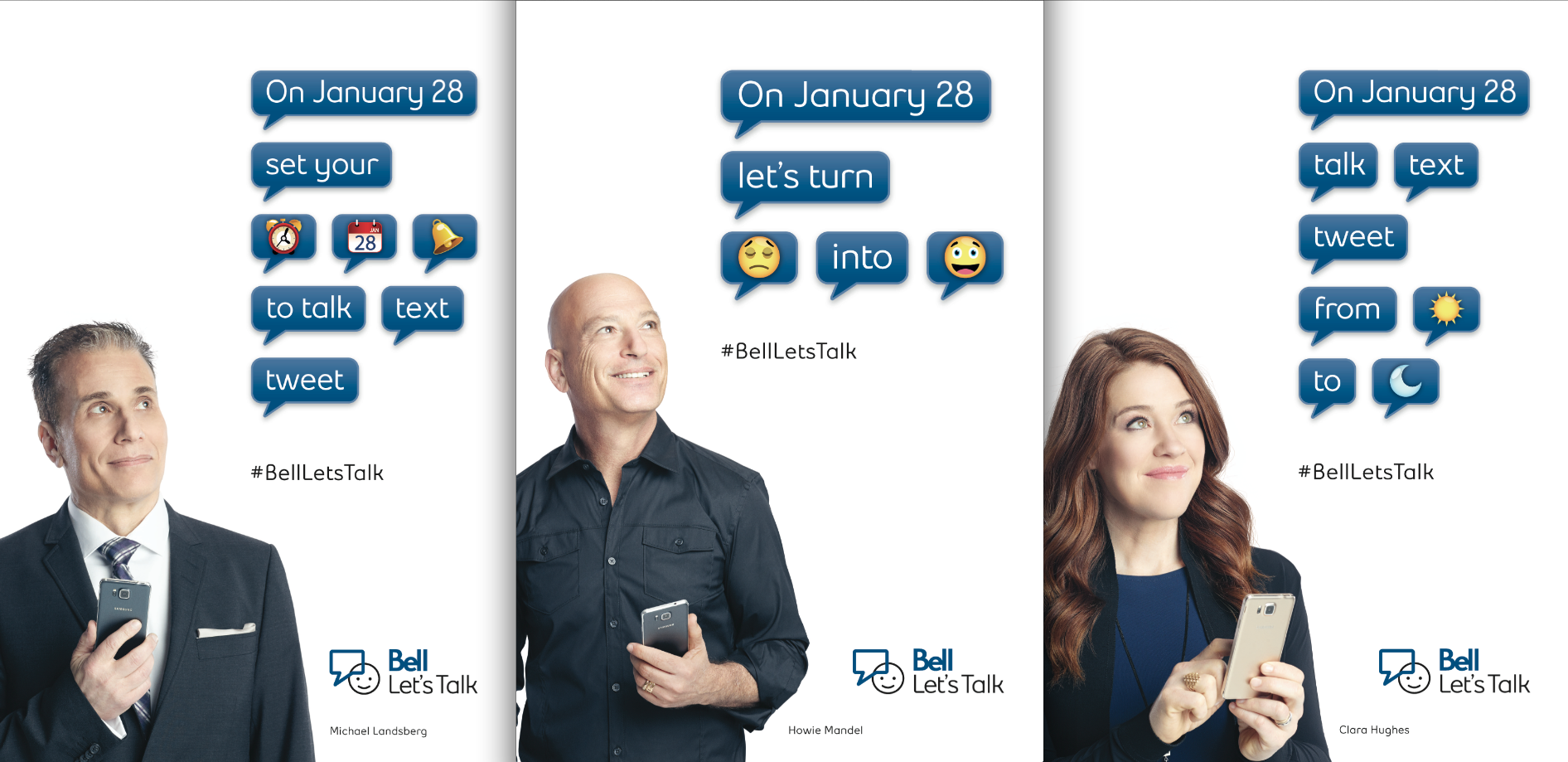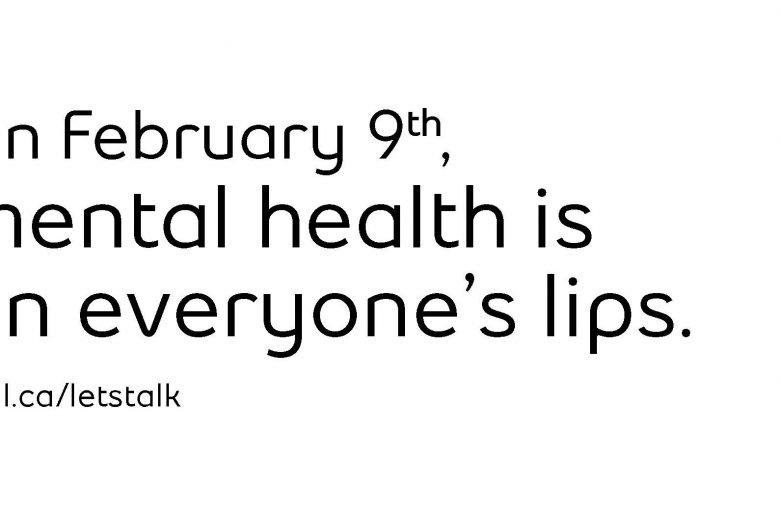Bell Let’s Talk – Long term Success
Long Term Success (SILVER)
Client Credits: Bell Canada
Rick Seifeddine, Senior Vice-President, Brand
Élaine Bisonnette, Director, Brand Strategy
François D’Amour, Associate Director, Brand
Agency Credits: lg2
Vice-President and Creative Director – Marc Fortin
Creative Directors – Nicolas Dion, Marilou Aubin
Art Directors – Patrick Beauchemin, Patrick Rochon, Alexandre Jourdain, Thibault Gehard
Art Directors – Jennifer Varvaresso, Simon Touzin
Copywriters – Sylvain Dufresne, Jean-François Perreault, Frédéric Tremblay, Stuart Macmillan
Copywriters – Éric Beaudin, Simon Touzin
Strategic Planning – Alexis Robin, Sabrina Côté, Rafik Belmesk
Account Services – Samia Chebeir, Alexandre Normand, Thalie Poulin, Nataly Lemyre, Safia Dodard
Account Services – Elsa Vilarinho
Agency Producers – Isabelle Fonta, Claudia Lemire
Print Production – lg2fabrique
Web Production – lg2fabrique
Photographers – Jean Malek, Raphaël Ouelet, John Londono
Director – Emanuel Hoss-Desmarais, Quatre Zéro Un
DOP – Sara Mishara
Sound and Music – BLVD, Boogie Studio
Post-Production – Vision Globale
Illustrator – François Boutet
Media Agency – Médias Experts
Section I — BASIC INFORMATION
| Business Results Period (Consecutive Months): | January 2011 – January 2015 |
| Start of Advertising/Communication Effort: | January 2011 |
| Base Period as a Benchmark: | 2010 |
Section II — SITUATION ANALYSIS
a) Overall Assessment
One in five Canadians will experience a form of mental illness at some point in their lives. Despite being such a widespread issue, very little had been done to raise awareness of it. Sadly, mental illness is still misunderstood and stigmatised, with two out of three people in Canada choosing to hide their suffering for fear of judgment or rejection.
As a result, the conversation about mental health among Canadians has been a true challenge for years. And with more than 500,000 Canadians missing work everyday due to a form of mental illness, this situation also has major economic implications.
As a Canadian telecommunication leader Bell felt it could play a key role in tackling this important issue. The ‘Let’s Talk’ national campaign was first launched in 2011 with the objective of getting Canadians talking about mental illness, helping to erase the stigma surrounding mental health and empowering people who live with mental health challenges by giving them a way to reach out and seek help. It also became a key opportunity to raise significant funds for mental health related initiatives, all in addition to Bell’s commitment of $50M to the cause over 5 years.
‘Bell Let’s Talk Day’ has been a yearly event since 2011. It takes place at the beginning of each year, when people have a tendency of being more depressed. The campaign to promote ‘Bell Let’s Talk Day’ starts a few weeks prior to the actual event. On the specifically appointed day, Bell gives 5¢ towards mental health-related initiatives for every long-distance call made or text message sent by a Bell customer. Additionally, since 2013, each tweet posted on Twitter using the #BellLetsTalk hashtag or shares of a dedicated Bell Let’s Talk image on Twitter and Facebook generates an additional 5¢ for the cause.
b) Resulting Business Objectives
From the beginning, Bell’s objectives with the ‘Let’s Talk’ campaign have been:
- To concentrate its efforts upon the mental health cause and become the advocate for it.
- To help reduce the stigma associated with mental illness by getting people talking.
- To raise funds to support mental health initiatives in Canada.
c) Annual Media Budget
$1 – $2 million
d) Geographic Area
Canada
Section III — STRATEGIC THINKING
a) Analysis and Insight
The cause industry is in crisis.
The good citizenship imperative that brands face nowadays combined with the need for corporations to be socially engaged has left consumers overwhelmed and bombarded with messages asking them to care and give to a particular cause.
The saturation goes further when multiple brands get behind the same cause and individually promote their brand association with that cause. This has made it extremely difficult for a brand to stand out in consumers’ eyes.
But this being said, too few brands have actually rolled up their sleeves and really gotten involved in the cause that they support. Most tend to sign a big cheque and run an ad about it. Not many brands are willing to go beyond the superficial and get involved with the root of the problem.
So if corporations aren’t leading the way by getting socially involved in a cause, how can consumers see any meaning in a brand asking them to support its cause?
People are too busy to care and give.
Consumers’ lives are already busy enough; 24 hours aren’t enough in a day to get things done. People don’t have time to shop around for the right brand supporting the right cause, regardless of their degree of motivation. In addition, supporting a cause often requires them to step out of their routine to actually contribute to the cause in one way or another.
How can Bell stand out in the crowded cause industry? How can Bell own the cause of mental health? And how can Bell motivate people to do something about it? By building its donation strategy based on this simple insight: People want to look good by saying they gave, without having to step out of their way to give. Simply put, donating has to be effortless.
b) Communication Strategy
Since the first year of the campaign, the strategy has been to get people to “talk” about mental health. The very human act of communicating (talking, texting) is intrinsically tied to Bell’s core business. It became clear that this would be the strategic handle that would be broadcast in the main message and the creative execution, but also trigger the mechanics that would get people to act/donate, without any supplementary effort, and would help to break the stigma.
To ensure the campaign would have an impact and that Canadians would get involved, every communications piece tied to ‘Let’s Talk’ day had to be rooted in the following strategies:
- Build on what Bell’s core business is already about: connecting people.
- Get people to help the cause through effortless activities they were already performing, without disrupting their daily routine.
- Project the issue onto centre-stage; encouraging people who are suffering in silence to open up about their own battles with mental illness and to seek help.
- Associate the cause with diverse, charismatic and likable spokespeople that Canadians from all provinces, backgrounds and walks of life can relate to.
- Generate a conversation on social medias to get people to openly talk about mental health and help break the stigma surrounding it.
As social media became more and more important, we had to stay current and bring the conversation to where the people were already discussing and sharing stories. This extended our reach and kept the conversation going about mental health. By adding Twitter and Facebook components to the campaign, we gave a voice to Canadians, encouraging them to take a stand for mental health and aiding in breaking the stigma.
The more Canadians openly talk about mental illness, the more they reduce the stigma and help the millions suffering in silence.
Section IV — KEY EXECUTIONAL ELEMENTS
a)Media Used
TV
Radio
OOH
Print
Online
Social media
b)Creative Discussion
Year 1 (2011)
Six-time Olympic medallist Clara Hughes, having also suffered from mental health issues, was chosen to be the first spokesperson for the ‘Bell Let’s Talk Day’ Clara was leveraged in all communications, enticing Canadians to talk about mental health.
Her message encouraged people to talk and text for the cause. On February 9th, 5¢ was donated to mental health initiatives for each text message sent and long-distance call made by Bell customers on that day.

Year 2 (2012)
In addition to the previous year’s spokesperson, Clara Hughes, two high profile spokespeople who have also overcome severe cases of mental illness were added – pop singer Stefie Shock and African-Canadian comedian Michel Mpambara – to reach the Quebec market.
Through their iconic smiles – a universal sign of people overcoming difficulties and an expression of Bell’s “Today just got better” brand promise – the campaign adopted a simple, yet compelling approach that would encourage Bell customers to make long distance calls, text, share their smiles on Facebook and retweet Bell’s Twitter message about donating 5¢ to mental health initiatives.
Year 3 (2013)
As the campaign evolved, our goal became to foster conversations and awareness earlier on, ahead of ‘Bell Let’s Talk Day’, to make sure that the impact would be further maximised. This is why, starting in 2013, we opted for a two phased approach: an awareness phase aimed at initiating conversations and getting a maximum amount of attention trained on mental health related issues and then a second phase that focused solely on engaging Canadians to participate to the important ‘Let’s Talk Day’.
Awareness phase: Starting a month before ‘Let’s Talk Day’, the initial phase aimed to generate awareness for the cause and the stigma too often associated with mental health related issues. The creative pieces, which built on this notion, had their own unique branding, different from Bell’s white and blue universe. The moving messages portrayed simple and real life examples of mental illness and served to give the ‘Let’s Talk’ cause its own clear identity…one that every Canadian could relate to.
Call to action phase: Approximately two weeks ahead of ‘Bell Let’s Talk Day’, a new set of creative was released, overlapping previous assets already in market. The new creative pieces reaffirmed Bell’s role (now sporting the white and blue branding) but also aimed to encourage participation on the official day. These messages also featured charismatic, likeable spokespersons associated to the cause for their past experiences with mental health related issues (Clara Hughes, Seamus O’Reagan (new spokesperson; ex-host on CTV’s Canada AM), Stefie Shock and Michel Mpambara). To maximise clarity, these messages focused on the simple act of texting: “The more you text, the more you help…Let’s talk”. The creative device was directly linked to the mechanic of the campaign (text messaging). Used across all medias, the text messaging bubbles reinforced our message.

Year 4 (2014)
The 4th year of the campaign leveraged the previous creative that had procured great results and was still relevant to consumers. The website was completely redesigned to allow for user generated content where tweets were put forward to generate a conversation on the importance of mental health. New content was provided in the form of a downloadable toolkit that offered guidelines to help start a conversation around mental health. We also gave information on how people can seek help for themselves or to help loved ones.

Year 5 (2015)
Now in its 5th year, the campaign presented clear challenges. We needed to avoid a general “fatigue” and assure that this national conversation included an even greater number of Canadians. Still divided into 2 phases, the campaign followed the same structure in terms of messaging in the market. Along with Clara Hughes, Stefie Shock and Michel Mpambara, new spokespeople including Howie Mandel (host of NBC’s Deal or No Deal, judge of America’s Got Talent), Michael Landsberg (host of TSN’s Off The Record) and Mary Walsh (well-known comedian) rallied to the cause. Their collaboration brought the message to another level. By not only associating themselves with the cause but by sharing their mental health related stories, they inspired thousands to do the same.
Awareness phase: This year’s awareness phase focused on education: drawing a real and unfiltered portrait of the impact of mental health related issues in Canada and giving Canadians concrete ways to help. These ‘Let’s Talk 5 Ways to Help’ (choose the right words, educate yourself, be kind, listen & ask, talk about it) were pioneered with mental health specialists and the client. One of our main goals was to extend our reach to youth. Based on the idea of a vine video and an animated gif, which would appeal to our newest target audience, the executions showed a repetitive and non-desirable behaviour towards someone suffering from a mental illness. The loop would then change and reveal one of the 5 ways to help break the stigma surrounding mental health issues.

Call to action phase: This year’s CTA phase relied on the fact that helping is easy. Participation for ‘Bell Let’s Talk’ was effortless, contagious and broad. Our spokespeople brought to life the importance of taking a stand on ‘Bell Let’s Talk Day’ through simple imagery that all of us use everyday – emoticons. On the official day, social media platforms were the hub of the campaign, allowing all Canadians (and not only Bell customers) to participate. Influencers on each platform were contacted and involved from the get-go. Sharable media assets were also developed with the goal to increase awareness and participation on the day but also during the weeks leading up to the big day.

Year after year, we had to make sure that the creative output evolved with the growth of the campaign in order to keep getting outstanding results. By pushing the initial strategy a little further every year and keeping true to its essence, we managed to keep Canadians involved in the cause.
c)Media Discussion
Each year, an extensive media plan was developed to heavily promote ‘Bell Let’s Talk Day’ (television, OOH, print, radio, PR, online and social media). The plan unfolded throughout French and English Canada an average of 6 weeks prior to ‘Bell Let’s Talk Day’.
Bell leveraged its vast network of partners and media properties to guarantee a dominating presence across Canada throughout the campaign. Furthermore, an extensive PR campaign lead by Clara Hughes allowed for primetime coverage for the cause, especially on ‘Bell Let’s Talk Day’. The other official spokespeople also contributed by conducting various interviews sharing their stories and inviting Canadians to participate in Bell’s effort.
On ‘Bell Let’s Talk Day’, the #BellLetsTalk hashtag and @BellLetsTalk twitter account were promoted on Twitter. The Bell Canada Facebook account also released the dedicated image to be shared. All other media invited Canadians to text to support the cause.
The importance of the social web: Social media became key as the campaign grew because it allowed for a public dialogue to take place on dedicated Facebook and Twitter environments. While the overall number of social media occurrences (tweets and Facebook posts) was far less than the amount of calls made and texts sent, the impact was no less significant. Publically shared posts and tweets gave consumers a chance to get involved in the discussion surrounding mental health. People who suffered had a platform to safely express themselves. Furthermore, social media initiatives also allowed Bell to reach past its own customer base, calling on all Canadians to get involved. And they did.
Section V — BUSINESS RESULTS
a) Sales/Share Results
Bell’s “Let’s Talk” message resonated overwhelmingly throughout the years with Canadians and got them to contribute to “life getting better” for other Canadians, thus leveraging Bell’s corporate brand promise and generating impressive results.
Bell: advocate of mental health
During the past 5 years, top of mind awareness of Bell’s support of mental health increased by an impressive 40% making Bell the leader in supporting mental health.
The awareness around ‘Bell Let’s Talk Day’ reached the impressive bar of 75% in some provinces. Nationally, the event gained 27% in awareness between 2011 and 2015 with a steady progression averaging approximately 5% per year.
Giving more to the cause
Over the years, the campaign has leveraged close to 500 million communication occurrences per year thus generating a total of almost $24M for the cause. This is an 85% increase from its last edition over the first edition. Year after year, our goal of motivating people to take action, support the cause and talk about mental health was tremendously successful. The number of interactions keeps increasing, continuously breaking the previous year’s record as well as Bell’s own record of number registered text messages in one day. In 5 years, we jumped from 66,079,236 to 122,150,772 interactions, an 85% increase.
Thanks to these amazing results, Bell decided to raise its original commitment of $50M to the cause over 5 years to $76M.
Let’s talk about it
Most importantly, our campaigns helped millions of Canadians feel more comfortable talking about mental health issues. Since the initiative first launched, 17% more people believe that ‘Bell Let’s Talk Day’ encourages a discussion on mental health.
Social media activity also played a key role in bringing the conversation to life in the latest editions of the campaign. The results reached their peak in the 2015 edition, with an increase in participation of 58% on Twitter alone. Social media participation allowed Bell to generate a significant lift in its followers on Twitter by 56% (from 43K to 76.5K followers) and Facebook accounts by 50% (from 44K to 88.5K fans). It also cemented the presence of ‘Bell Let’s Talk’ on Instagram generating more than 500 followers on this new platform for the brand. The big story is on Twitter in 2015, where the number of interactions reached record setting levels, with 4,775,708 tweets reported on a single day and making #BellLetsTalk the number one trending worldwide hashtag on that day.
Influencers helped Bell with their impressive achievement of the number one ranking on Twitter. Through personalities such as Stephen Harper, Sophia Bush, Bryan Adams, Justin Bieber and Ellen DeGeneres, we not only extended our reach but reinforced our position regarding the importance of talking about mental health. Even our competitors joined the parade.
The depth of testimonials and messages of hope shared by Canadians on that day highlights the most important metric of this campaign, each one breaking down the wall of stigmatisation, one story at a time.
With this continued success, we are hopeful that Bell will renew its commitment towards mental health. The conversation is definitely started and needs to keep reaching more and more Canadians every year.
b) Consumption/ Usage Results
–
c) Other Pertinent Results
–
d) Return on Investment
–
All results provided by client.
Section VI — CAUSE & EFFECT BETWEEN ADVERTISING AND RESULTS
a)General Discussion
Apart from the yearly Bell Let’s Talk initiative, no marketing promotions or communications activities to grow volume in text messages and/or calls, or other social media initiatives driven by Bell were in market between January 2011 – January 2015. The ‘Bell Let’s Talk’ campaign influenced the constant increase of conversation amongst Canadians on the day of the initiative, and therefore the results. But most importantly, it contributed year after year to get people talking about mental health and to help reduce the stigma.
Awards for Bell Let’s Talk
2013:
- Cassies – Bronze: Events, Seasonal and Short-Term
- Cause + Action by Strategy Magazine – Overall winner
- Boomerang Awards – Prize: Social media strategy
- Boomerang Awards – Grand prize: Integrated campaign
2014:
- Boomerang Award – Prize: Social media strategy
- Créa Awards – Prize: Film, Non-profit organization
b)Excluding Other Factors
Spending Levels:
The spending level was equivalent each year.
Pricing:
–
Distribution Changes:
–
Unusual Promotional Activity:
–
Other Potential Causes:
No other potential causes.
